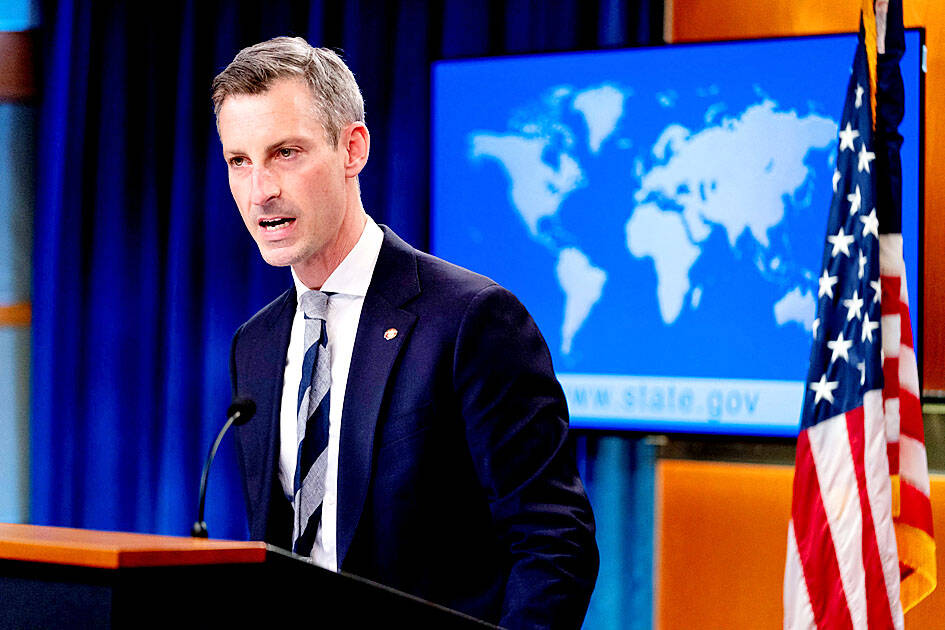US Department of State spokesman Ned Price on Monday said that Washington does not take a position on the sovereignty issue between Taiwan and China, a position not often explicitly stated by US officials.
Price was responding to a question at a news briefing on whether Washington’s “one China” policy supported the belief that “Taiwan is part of China and that the US respects Chinese territorial integrity and sovereignty over Taiwan.”
The US “does not take a position on sovereignty,” Price said, adding that Washington’s “one China” policy has not changed and has been at the crux of the US’ approach to Taiwan since 1979, when the US’ Taiwan Relations Act went into effect.

Photo: Reuters
That is a position that US Secretary of State Antony Blinken “made very clear in private” to Chinese Minister of Foreign Affairs Wang Yi (王毅) when the two met on Friday, Price said.
He did not further define the US’ “one China” policy, but said that the US wanted to see the “status quo” in the Taiwan Strait continued and preserved, as it had undergirded peace and stability in the region for more than 40 years.
China, which has become more “coercive and intimidating in its actions and maneuvers across the Taiwan Strait,” apparently does not share the same hope, he added.
Beijing has accused the US of hollowing out its “one China” policy and supporting Taiwan’s independence, and has stepped up military maneuvers near Taiwan, most notably after US House of Representatives Speaker Nancy Pelosi visited Taipei early last month.
It has been Washington’s long-standing policy to not take a position on Taiwan’s sovereignty, but US officials have rarely made known that stance publicly.
One such instance was when then-Pentagon press secretary John Kirby at a news conference on Oct. 12 last year spoke about the difference between the US’ “one China policy” and Beijing’s “one China principle.”
The US has long abided by its “one China policy,” which is distinct from Beijing’s “one China principle,” which asserts sovereignty over Taiwan, Kirby said at the time.
The US “takes no position over the sovereignty of Taiwan or on sovereignty over Taiwan,” Kirby said.
In May, Price wrote on social media that the US abides by its “one China” policy and does not subscribe to China’s “one China” principle, criticizing China for “continuing to publicly misinterpret the US’ policy.”

A car bomb killed a senior Russian general in southern Moscow yesterday morning, the latest high-profile army figure to be blown up in a blast that came just hours after Russian and Ukrainian delegates held separate talks in Miami on a plan to end the war. Kyiv has not commented on the incident, but Russian investigators said they were probing whether the blast was “linked” to “Ukrainian special forces.” The attack was similar to other assassinations of generals and pro-war figures that have either been claimed, or are widely believed to have been orchestrated, by Ukraine. Russian Lieutenant General Fanil Sarvarov, 56, head

SAFETY FIRST: Double the number of police were deployed at the Taipei Marathon, while other cities released plans to bolster public event safety Authorities across Taiwan have stepped up security measures ahead of Christmas and New Year events, following a knife and smoke bomb attack in Taipei on Friday that left four people dead and 11 injured. In a bid to prevent potential copycat incidents, police deployments have been expanded for large gatherings, transport hubs, and other crowded public spaces, according to official statements from police and city authorities. Taipei Mayor Chiang Wan-an (蔣萬安) said the city has “comprehensively raised security readiness” in crowded areas, increased police deployments with armed officers, and intensified patrols during weekends and nighttime hours. For large-scale events, security checkpoints and explosives

PUBLIC SAFETY: The premier said that security would be tightened in transport hubs, while President Lai commended the public for their bravery The government is to deploy more police, including rapid response units, in crowded public areas to ensure a swift response to any threats, President William Lai (賴清德) said yesterday after a knife attack killed three people and injured 11 in Taipei the previous day. Lai made the remarks following a briefing by the National Police Agency on the progress of the investigation, saying that the attack underscored the importance of cooperation in public security between the central and local governments. The attack unfolded in the early evening on Friday around Taipei Main Station’s M7 exit and later near the Taipei MRT’s Zhongshan

REBUFFED: In response to Chinese criticism over recent arms sales, Washington urged Beijing to engage in meaningful dialogue instead of threats and intimidation Washington’s long-term commitment to Taiwan would not change, the US Department of State said yesterday, urging Beijing to stop pressuring Taiwan and engage in meaningful bilateral dialogues. The remarks came in response to a backlash from Beijing about Washington’s latest approval of arms sales to Taiwan. The US Defense Security Cooperation Agency said in a statement on Wednesday that the Taipei Economic and Cultural Representative Office in the US has asked to purchase an arms package, including Tactical Mission Network Software; AH-1W helicopter spare and repair parts; M109A7 self-propelled howitzers; HIMARS long range precision strike systems; tube-launched, optically tracked, wire-guided missiles; Javelin